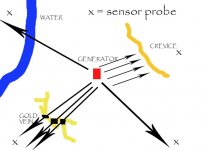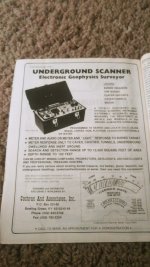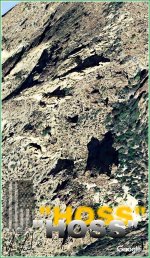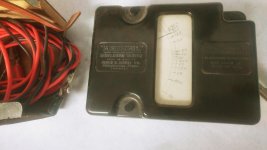back in the 80's i walked into pro-mack prospecting shop in apache junction...sitting on the counter was a ray gun looking thing with 3 antenna's sticking out of it..i asked elaine what the hell it was...she said it was a long range locator called the thomas electroscope...fred came out and demonstrated it ....i was hooked and had to have it...so $900 later i was the new owner...i was the first idiot in the valley to own one so as soon as people found out i had one i was getting calls from people wanting me to scan their property...i got a call from a man that called himself hoss and he said he had a job for me...a couple had hired hoss to locate a mayo jar full of gold teeth that their father had brought back from ww2 (dont ask how he got them)...the father had passed away and they couldn't find the jar of teeth..hoss scanned their property and house with a metal detector and came up empty...so he brought me in and i gave the place a going over with the electroscope...the only thing i turned up was a jar of coins up high in the closet...then the wife mentioned something about her brother was the first one in the house after dad passed..hoss and i looked at each other and hung our heads..we both knew right then what happened to the jar full of gold teeth ...some of you guys on here probably knew hoss..he went on to become a pretty well known treasure hunter and metal detectorist
Navigation
Install the app
How to install the app on iOS
Follow along with the video below to see how to install our site as a web app on your home screen.
Note: This feature may not be available in some browsers.
More options
You are using an out of date browser. It may not display this or other websites correctly.
You should upgrade or use an alternative browser.
You should upgrade or use an alternative browser.
allen "hoss" blackman
- Thread starter azdave35
- Start date
ORO18
Jr. Member
- Aug 17, 2017
- 58
- 58
- Detector(s) used
- Whites MXT w blue coil, minelab...
- Primary Interest:
- All Treasure Hunting
gollum
Gold Member
- Jan 2, 2006
- 6,770
- 7,719
- Detector(s) used
- Minelab SD2200D (Modded)/ Whites GMT 24k / Fisher FX-3 / Fisher Gold Bug II / Fisher Gemini / Schiebel MIMID / Falcon MD-20
- Primary Interest:
- All Treasure Hunting
back in the 80's i walked into pro-mack prospecting shop in apache junction...sitting on the counter was a ray gun looking thing with 3 antenna's sticking out of it..i asked elaine what the hell it was...she said it was a long range locator called the thomas electroscope...fred came out and demonstrated it ....i was hooked and had to have it...so $900 later i was the new owner...i was the first idiot in the valley to own one so as soon as people found out i had one i was getting calls from people wanting me to scan their property...i got a call from a man that called himself hoss and he said he had a job for me...a couple had hired hoss to locate a mayo jar full of gold teeth that their father had brought back from ww2 (dont ask how he got them)...the father had passed away and they couldn't find the jar of teeth..hoss scanned their property and house with a metal detector and came up empty...so he brought me in and i gave the place a going over with the electroscope...the only thing i turned up was a jar of coins up high in the closet...then the wife mentioned something about her brother was the first one in the house after dad passed..hoss and i looked at each other and hung our heads..we both knew right then what happened to the jar full of gold teeth ...some of you guys on here probably knew hoss..he went on to become a pretty well known treasure hunter and metal detectorist
Hey Buddy,
Don't know about Blackman, but my buddy Carl Moreland is an R&D Electrical Engineer for Fisher/First Texas (previously White's). Here is a link to his old website where he dissects many LRL's (Long Range Locators). The Electroscope Model 20 is one:
https://www.geotech1.com/cgi-bin/pages/common/index.pl?page=lrl&file=reports/escope20/index.dat
Interesting info on all types of detectors on his site. Also very interesting info on the founder of Electroscope (Thomas Afilani). Somehow Electroscope is still in business. Here is a a link to a test Sandia Labs performed on a device designed by Afilani to help military and SAR find people behind walls:
https://www.pitt.edu/~kconover/dkl.htm#Sandia and Army Tests
(Spoiler: Its Shite!)
Mike
- Thread starter
- #5
hi mike...years ago i corresponded with carl quite a bit..he has alot of good stuff on his website...he really had it in for long range locators..lolHey Buddy,
Don't know about Blackman, but my buddy Carl Moreland is an R&D Electrical Engineer for Fisher/First Texas (previously White's). Here is a link to his old website where he dissects many LRL's (Long Range Locators). The Electroscope Model 20 is one:
https://www.geotech1.com/cgi-bin/pages/common/index.pl?page=lrl&file=reports/escope20/index.dat
Interesting info on all types of detectors on his site. Also very interesting info on the founder of Electroscope (Thomas Afilani). Somehow Electroscope is still in business. Here is a a link to a test Sandia Labs performed on a device designed by Afilani to help military and SAR find people behind walls:
https://www.pitt.edu/~kconover/dkl.htm#Sandia and Army Tests
(Spoiler: Its Shite!)
Mike
gollum
Gold Member
- Jan 2, 2006
- 6,770
- 7,719
- Detector(s) used
- Minelab SD2200D (Modded)/ Whites GMT 24k / Fisher FX-3 / Fisher Gold Bug II / Fisher Gemini / Schiebel MIMID / Falcon MD-20
- Primary Interest:
- All Treasure Hunting
hi mike...years ago i corresponded with carl quite a bit..he has alot of good stuff on his website...he really had it in for long range locators..lol
Well, he's an Electrical Engineer. He believes what he was taught! When Tim at A&B Prospecting wanted me to come see him demonstrate the new "Digital" Electroscope at the shop, I asked the one question no LRL Apologist can answer.............."How can it give an accurate reading in the store, when you have gold samples there? Wedding ring? Gold Chain?" LOL
All Electroscopes are just Dowsing Rods with a BS 555 Circuit(usually). I suppose the new digital model is probably some kind of EM Sensor (I would have to handle it and see the circuit wiring and chips used).
Mike
Last edited:
- Thread starter
- #7
mike..i've had a few electroscopes over the year (i still have one).the first one i bought i cracked the case open and was amazed at what was in it..my friend dale was an electronics guy and we hooked it up to a scope and checked it with a meter..what thomas basically did was put voltage to the antennas..he had a few switches and knobs on it and all they did was vary the voltage to the antenna...there was a few problems with the old electroscopes...once you figured out what they were and corrected them it did ok..i found a few things with mine..nothing spectacular ..but i did find an 1882 silver dollar with itWell, he's an Electrical Engineer. He believes what he was taught! When Tim at A&B Prospecting wanted me to come see him demonstrate the new "Digital" Electroscope at the shop, I asked the one question no LRL Apologist can answer.............."How can it give an accurate reading in the store, when you have gold samples there? Wedding ring? Gold Chain?" LOL
Mike
gollum
Gold Member
- Jan 2, 2006
- 6,770
- 7,719
- Detector(s) used
- Minelab SD2200D (Modded)/ Whites GMT 24k / Fisher FX-3 / Fisher Gold Bug II / Fisher Gemini / Schiebel MIMID / Falcon MD-20
- Primary Interest:
- All Treasure Hunting
mike..i've had a few electroscopes over the year (i still have one).the first one i bought i cracked the case open and was amazed at what was in it..my friend dale was an electronics guy and we hooked it up to a scope and checked it with a meter..what thomas basically did was put voltage to the antennas..he had a few switches and knobs on it and all they did was vary the voltage to the antenna...there was a few problems with the old electroscopes...once you figured out what they were and corrected them it did ok..i found a few things with mine..nothing spectacular ..but i did find an 1882 silver dollar with it
I give none of them any credit for anything. LOL I was a Communications guy for many years in both the Navy and Army. I know a LOT about antennas and wave propagation. Here is the second problem with Electroscopes:
You are supposed to aim the antennas towards, or the antennas move towards (aiming at) the target. Ever wonder why TV Antennas point up? That type of antenna is called a Dipole Omnidirectional Antenna. The area best reception is in the shape of a large donut (mmmmmmmmmm donut) that circles the pole of the antenna. The direction the antenna tip is pointing is the absolute weakest area of reception. If the Electroscope was designed to actually work, Afilani would have used a flat Directional Antenna or a Yagi Antenna. That way, the area of strongest reception is where you point it (or where it points).
I have a million little issues like that with LRLs.
Buuuuuuuuuuuuuuuuut............ I do believe there are people that can actually dowse (just not as many as claim they can).
Mike
- Thread starter
- #9
mike..basically if you have no dowsing ability...then you cant use something like an electroscope...its a cool looking ray gun...but a dowser can do the same thing with a bent welding rod....dale and i did tons of research on alot of lrl's back in the 80's ..we messed with them for years...dale designed one that we built and sold for a while...it was a different design than the electroscope though...more like the old omnitron...you drove metal rods in the ground and hooked a frequency generator to them and pumped the signal through the groundI give none of them any credit for anything. LOL I was a Communications guy for many years in both the Navy and Army. I know a LOT about antennas and wave propagation. Here is the second problem with Electroscopes:
You are supposed to aim the antennas towards, or the antennas move towards (aiming at) the target. Ever wonder why TV Antennas point up? That type of antenna is called a Dipole Omnidirectional Antenna. The area best reception is in the shape of a large donut (mmmmmmmmmm donut) that circles the pole of the antenna. The direction the antenna tip is pointing is the absolute weakest area of reception. If the Electroscope was designed to actually work, Afilani would have used a flat Directional Antenna or a Yagi Antenna. That way, the area of strongest reception is where you point it (or where it points).
I have a million little issues like that with LRLs.
Buuuuuuuuuuuuuuuuut............ I do believe there are people that can actually dowse (just not as many as claim they can).
Mike
gollum
Gold Member
- Jan 2, 2006
- 6,770
- 7,719
- Detector(s) used
- Minelab SD2200D (Modded)/ Whites GMT 24k / Fisher FX-3 / Fisher Gold Bug II / Fisher Gemini / Schiebel MIMID / Falcon MD-20
- Primary Interest:
- All Treasure Hunting
mike..basically if you have no dowsing ability...then you cant use something like an electroscope...its a cool looking ray gun...but a dowser can do the same thing with a bent welding rod....dale and i did tons of research on alot of lrl's back in the 80's ..we messed with them for years...dale designed one that we built and sold for a while...it was a different design than the electroscope though...more like the old omnitron...you drove metal rods in the ground and hooked a frequency generator to them and pumped the signal through the ground
What y'all built was a ground resistivity detector. I have always liked the idea of that. Problem is, if you are using batteries, you won't have enough power to move a signal more than five or ten feet in the ground. The only way that would work for what you want would be to use about 2 5kilowatt generators. Hammer a six foot copper grounding rod into the ground and run a heavy gauge wire to the positive connector. About a mile or so away, do the same thing with the other generator, only use the negative connector. The actual wattage of the generator needed will depend on the type of ground and mineralization. Might be able to get a set of rods moving that way, or use one generator and one ground rod. Use the rod like an omnidirectional radio antenna. If you are pushing a resonant frequency of gold or silver, you might get the rods moving that way.
My guess is that it would take a LOT of trial and error to test distance, freq, power output, ground types, etc. Could be done though. I'll see if my "go to guy" has ever done anything of the sort. My friend Dr. Lambert Dolphin was chief physicist at SRI for about 35 years before he retired. He is also known as the Father of modern ground penetrating radar. He was the guy (he and the other scientists at SRI) that Chuck Kenworthy used to do all the ground testing for his treasure hunts. He also went to the Philippines with the Seagraves to look for Yama$hita's Treasure. Very interesting guy.
Mike
Last edited:
- Thread starter
- #11
mike...the ground resistivity meter was a whole different dog...those were called geophysical scanners and were made by manuel ortiz...he sold those for 10k back in the late 80's...i think carl has a write up on them on his website...we built one using a 500 volt hand crank megger...it actually worked pretty good if you didn't stretch the wires out too far...we sold one to a guy in california...he was using it to check the cracks in bedrock for trapped nuggets..he would drove a probe at one end of the crack...and another probe at the other...then check the resistivity between the probes...if he got a good reading then he would bust up the crack ..he made a small fortune using that methodWhat y'all built was a ground resistivity detector. I have always liked the idea of that. Problem is, if you are using batteries, you won't have enough power to move a signal more than five or ten feet in the ground. The only way that would work for what you want would be to use about 2 5kilowatt generators. Hammer a six foot copper grounding rod into the ground and run a heavy gauge wire to the positive connector. About a mile or so away, do the same thing with the other generator, only use the negative connector. The actual wattage of the generator needed will depend on the type of ground and mineralization. Might be able to get a set of rods moving that way, or use one generator and one ground rod. Use the rod like an omnidirectional radio antenna. If you are pushing a resonant frequency of gold or silver, you might get the rods moving that way.
My guess is that it would take a LOT of trial and error to test distance, freq, power output, ground types, etc. Could be done though. I'll see if my "go to guy" has ever done anything of the sort. My friend Dr. Lambert Dolphin was chief physicist at SRI for about 35 years before he retired. He is also known as the Father of modern ground penetrating radar. He was the guy (he and the other scientists at SRI) that Chuck Kenworthy used to do all the ground testing for his treasure hunts. He also went to the Philippines with the Seagraves to look for Yama$hita's Treasure. Very interesting guy.
Mike
sdcfia
Silver Member
- Sep 28, 2014
- 3,743
- 9,094
- Primary Interest:
- Other
I have a million little issues like that with LRLs.
Buuuuuuuuuuuuuuuuut............ I do believe there are people that can actually dowse (just not as many as claim they can).
Mike
That's right - dowsers seem to be hard-wired to be able to receive info from some range of the electromagnetic spectrum that few humans are tuned to. I'm normally a left-brain type, but I knew two folks (both now long deceased) who had the ability. I tested both of them myself with sections of random topo maps of my own choosing with all identifying text removed, then photo-copied. Just elevation contours showing. Then I hiked to the coordinates they provided to me - three targets from one guy and about 15 from the other on a different map. I attest that both shocked me with their results.
This isn't a dowsing discussion, but I agree with Dave that the LRL's possibly assist people with some degree of dowsing ability, realized or not.
gollum
Gold Member
- Jan 2, 2006
- 6,770
- 7,719
- Detector(s) used
- Minelab SD2200D (Modded)/ Whites GMT 24k / Fisher FX-3 / Fisher Gold Bug II / Fisher Gemini / Schiebel MIMID / Falcon MD-20
- Primary Interest:
- All Treasure Hunting
mike...the ground resistivity meter was a whole different dog...those were called geophysical scanners and were made by manuel ortiz...he sold those for 10k back in the late 80's...i think carl has a write up on them on his website...we built one using a 500 volt hand crank megger...it actually worked pretty good if you didn't stretch the wires out too far...we sold one to a guy in california...he was using it to check the cracks in bedrock for trapped nuggets..he would drove a probe at one end of the crack...and another probe at the other...then check the resistivity between the probes...if he got a good reading then he would bust up the crack ..he made a small fortune using that method
Ground resistivity is easy. You push a lot of electricity into the ground. Electricity has a natural flow that nulls on a meter. When that smooth flow of current is interrupted by a crevice, water, metal, etc, it shows on the meter. Works just like an Ohmmeter. Ohms are resistance. You get a base reading for natural resistance in the ground where there are no interruptions. You then introduce your own interruptions and see how they show on the meter. Your ground type and distance from the generator will determine necessary power.

Mike
- Thread starter
- #14
mike...the original geo underground scanner was basically a megger ...used for checking for shorts in underground wires...it put 500 volts in the ground while measuring the resistance between the probes...the omnitron however was totally different...it was basically a function generator that put a frequency through the ground and you picked up the signals with dowsing rods...here is the old geo scannerGround resistivity is easy. You push a lot of electricity into the ground. Electricity has a natural flow that nulls on a meter. When that smooth flow of current is interrupted by a crevice, water, metal, etc, it shows on the meter. Works just like an Ohmmeter. Ohms are resistance. You get a base reading for natural resistance in the ground where there are no interruptions. You then introduce your own interruptions and see how they show on the meter. Your ground type and distance from the generator will determine necessary power.
View attachment 1755460
Mike

- Thread starter
- #15
i still have the one we built...i'll dig it out and post a picmike...the original geo underground scanner was basically a megger ...used for checking for shorts in underground wires...it put 500 volts in the ground while measuring the resistance between the probes...the omnitron however was totally different...it was basically a function generator that put a frequency through the ground and you picked up the signals with dowsing rods...here is the old geo scanner
View attachment 1755461
Top Member Reactions
-
 3343
3343 -
 1971
1971 -
 1930
1930 -
 1181
1181 -
 1098
1098 -
 897
897 -
 810
810 -
 805
805 -
 798
798 -
 792
792 -
 774
774 -
 531
531 -
 494
494 -
 460
460 -
 443
443 -
 429
429 -
 424
424 -
 423
423 -
E
414
-
 386
386
Users who are viewing this thread
Total: 2 (members: 0, guests: 2)





